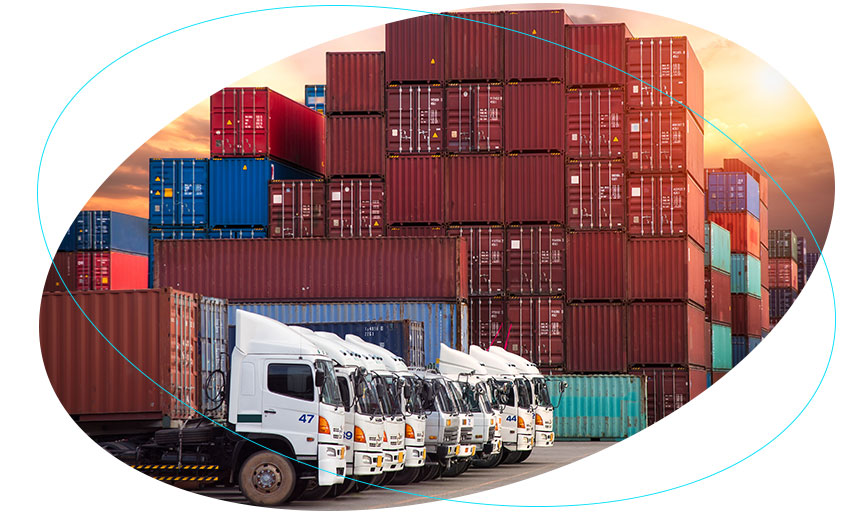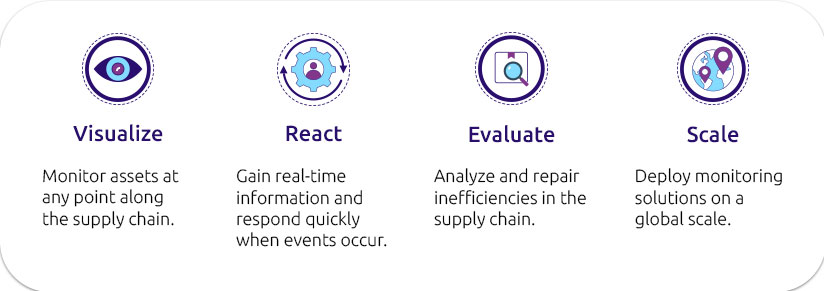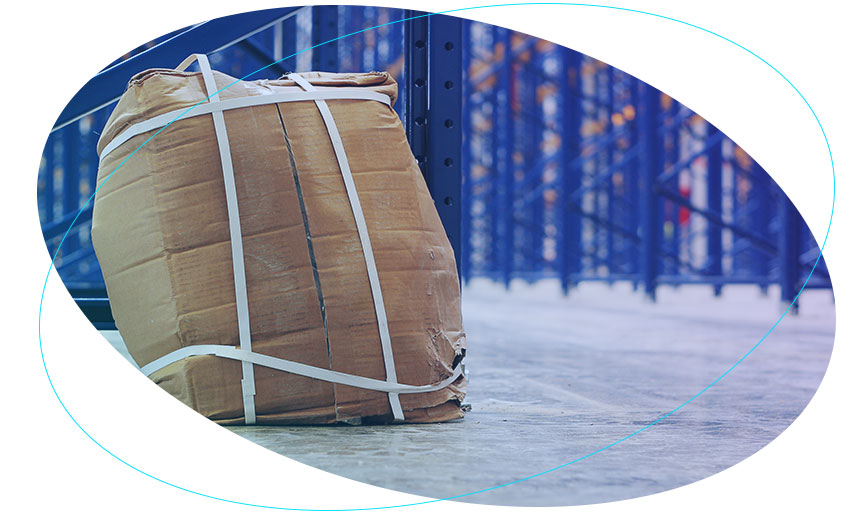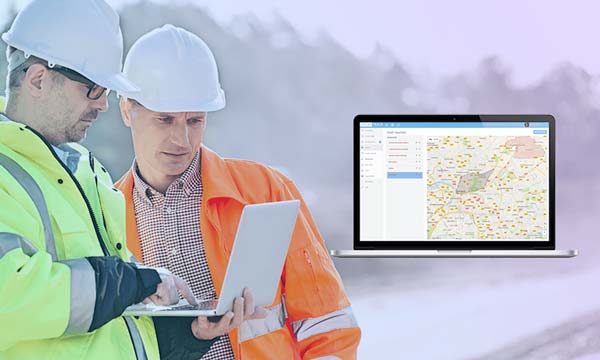THE NEW IOT-POWERED SUPPLY CHAIN: HOW SMART LOGISTICS TRACKING IS CREATING A LEANER, MORE AGILE GLOBAL ECONOMY

Sigfox’s IoT Network Transforms the Global Supply Chain
Executive Summary
- The logistics and transportation industry seeks a lean supply chain solution to improve upon RFID technology.
- Smart logistics solutions, powered by Sigfox’s global IoT network, allow the industry to visualize location and manage critical goods in real time.
- The new IoT supply chain streamlines field operations, reduces inefficiencies and delivers better insights that improve client service levels.
- Smart logistics solutions replace RFID tags as the premiere supply chain management tool.
Logistics and Transportation Industry Looks Beyond RFID Technology

For better or worse, we live in a complex, global world. No industry represents this complexity better than logistics and transportation. Most modern goods travel thousands of miles, changing hands half a dozen times or more, before they reach their final destinations.
In this complex landscape, missteps along the supply chain are unavoidable. No matter how solid the logistics network for a particular asset, at some point a truck will get stuck in traffic, or a crate will be delayed at a warehouse, or an asset will go missing altogether. With traditional supply chain management solutions, logistics managers often don’t find out about delayed or misrouted assets until those assets arrive hours late—or not at all—at their destinations. These hours translate into lost productivity, delayed production and damaged client relationships.

The logistics industry needs a way to pinpoint the location of assets in real time, as they travel along worldwide transportation routes. If a negative event occurs, early intervention could significantly reduce losses further down the supply chain. But when it comes to visualizing mobile assets, traditional RFID technology falls short.
Although RFID tags help track goods as they arrive at each destination, they give no information about what happens in between, leaving logistics managers largely in the dark about the state of the goods they are charged with moving safely, and quickly, through a complex supply chain.
Thanks to the internet of things (IoT) the logistics and transportation industry finally has a comprehensive solution for managing goods at every step along its logistics networks.

Representing the latest in IoT technology, smart logistics solutions have the power to transform the modern supply chain as we know it. For the first time, the industry can visualize and manage critical goods from anywhere, at any time, on a global scale.
Real-time Asset Tracking Streamlines Field Operations and Reduces Delay Costs
From a user perspective, smart logistics solutions are fairly straightforward to deploy. A small, batterypowered smart tracking device is securely mounted onto a container, truck or wagon carrying goods. Once mounted, the device collects real-time information about the exact location of those goods at any point along the supply chain and securely transmits that information through Sigfox’s global IoT network. The information can be aggregated on a customized app platform or connected directly to a company’s existing Logistic Information System.
Unlike most first-generation smart devices, objects that connect to the Sigfox network don’t rely on WiFi or 4G, so connectivity is never an issue, regardless of where an asset travels. Each device is plug and play, so no pairing or infrastructure is required and devices can be transferred as needed from one asset to another.

The level of data that these intelligent devices are able to collect and organize is unprecedented. A logistics manager can now pull up his app dashboard at any time to see up-to-the-minute information about the exact location of an asset, the speed at which it is moving, and it’s estimated arrival time based on current travel conditions. And when an asset does arrive at a location, automated time and date stamps replace the need to scan RFID barcodes altogether.
Streamline Field Operations Thanks to this unprecedented level of information, global companies have seen their supply chains become leaner and more efficient than ever before.
Take a company that manufactures smartphones. Each phone contains dozens of individually sourced components which must crisscross the globe, often stopping at multiple assembly points along the way, before the finished product is delivered to a warehouse or distribution center, and finally, to retailers.
In the past, a supply chain with this level of complexity was a logistics nightmare. If a question arose about the whereabouts of a particular component, a logistics manager at the smartphone company had to rely on limited information gathered through RFID tag scans. That manager might know with certainty that a shipment of components left a factory in China’s Hunan province, headed first by truck, then by rail and finally by boat, for an assembly plant in Taiwan. But what if the driver of the truck got misrouted and ended up at the wrong rail station, fifty miles in the wrong direction? Or what if a storm caused the boat to be delayed? Tracking a missing asset down while it is en-route is time-consuming at best. When that asset travels through areas with limited infrastructure, tracking becomes nearly impossible.
With smart logistics solutions, the logistics manager at the smartphone company can now see his entire logistics workflow in a single glance. He can watch assets in real time or dig deeper into the data on a single asset. And he can do this at any time, from anywhere. Now, when a question about a component arises, he does not need to spend hours on the phone, trying to connect with on-the-ground personnel. With his app dashboard acting as a virtual control tower, he can answer that question with the click of a button.
If any component requires special handling or temperature control, geolocation capabilities can be coupled with transportation conditions monitoring for added value. Now, a manager is also alerted if an asset falls outside a predetermined temperature range, or receives unexpected vibrations or shocks.
Reduce Delay-Related Costs
Not only can the smartphone logistics manager track the location of mobile goods with ease, but he receives real-time alerts that inform him of unexpected events. If a truck carrying components gets stuck in traffic, or travels away from a pre-determined route, the smart logistics app will issue an alert that informs the manager of the delay and gives a new estimated arrival time. Likewise, if a container traveling by boat or rail is delayed, the manager will learn about it in real time, instead of having to wait until it arrives late at its next destination.
These up-to-the-minute alerts allow that smartphone company to remain agile and respond quickly across a complex, global transportation network. Delayed assets can cause major disruptions further down the supply chain, but logistic managers now have the information they need to mobilize quickly. What could have been a costly disruption turns into a minor hiccup, thanks to smart logistics.
Receive Better Insights and Improve Client Service Levels
Of course, the final element needed to create a lean supply chain is constant improvement. It’s one thing to quickly address problems, but the true goal is to plan ahead and correct issues before they ever occur. Smart logistics solutions allow companies to evaluate and improve their supply chain networks with an unprecedented level of accuracy. The staggering amount of information about transportation routes, warehouse delays and network gaps acts as a complete audit trail, giving companies all of the data they need to analyze and repair inefficiencies in their supply chains.
As our global economy becomes even more complex and interconnected, the logistics and transportation industry must be at the forefront of innovation, helping create a roadmap for success. Undoubtedly, smart logistics solutions will remain a powerful ally in this process, giving the industry the tools it needs to remain lean and agile in an ever-changing world.
